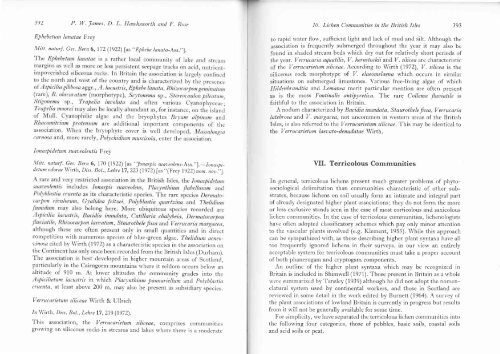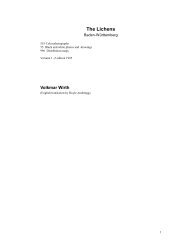Lichen communities in the British Isles: A preliminary conspectus
Lichen communities in the British Isles: A preliminary conspectus
Lichen communities in the British Isles: A preliminary conspectus
You also want an ePaper? Increase the reach of your titles
YUMPU automatically turns print PDFs into web optimized ePapers that Google loves.
392 P. W. James, D. L. Hazphsworth and F. Rose<br />
El>hehetum lanatae F rey<br />
Mitt. naturf. Ges. Bern 6, 172 (1922) fas,,Ephebe lanata-Ass."l.<br />
of algae and <strong>the</strong> bryophytes Bryu ancl<br />
Rh m are additional important com thc<br />
ass bryophyte cover is well develop ngia<br />
tar y, Polychidium muscicola, enter <strong>the</strong><br />
I onas pide turn su ats eolentis F r ey<br />
Mitt. naturf. Ges- Bern 6, 170 (1922) las "Jonaspis suaz,teolens-Lss."l.-Ionaspidetumodoraewirth,<br />
Diss.Bot.,LehreL7,223(1972)fas"(tlrey 1922)iom.roo.;,1.<br />
competition with numerous species of blue-green algae. Thelidium aeneo-<br />
'u^<strong>in</strong>osa cited by wirth (1972) as a characteristic species <strong>in</strong> <strong>the</strong> association on<br />
<strong>the</strong> orded from <strong>the</strong> <strong>British</strong> <strong>Isles</strong> (Durhanr).<br />
Th n higher mounta<strong>in</strong> areas ol Scotlanci,<br />
par ta<strong>in</strong>s where it seldom occurs below an<br />
altitude of 910 m. At lower altitudes <strong>the</strong> community grades <strong>in</strong>to <strong>the</strong><br />
Aspicilietum lacustris <strong>in</strong> u'hich Placynthium pannariellum and. polyblastia<br />
cruenta, at least above 200 m, may also be present as subsidiary species.<br />
Verrucarietum siliceae Wirth & Ullrich<br />
lz Wirth, Diss. Bot., Lehre 17,219 (1972)-<br />
This association, <strong>the</strong> verrucariehtm siliceae, comprises <strong>communities</strong><br />
grow<strong>in</strong>g on siliccous rocks <strong>in</strong> streams and lakes where <strong>the</strong>rc is a moderate<br />
10. <strong>Lichen</strong> Communities <strong>in</strong> <strong>the</strong> <strong>British</strong> <strong>Isles</strong> 393<br />
to rapid water flow, sufficient light and lack of mud and silt. Although <strong>the</strong><br />
association is frequently submerged throughout <strong>the</strong> year it may also bc<br />
found <strong>in</strong> shaded strcam beds which dry out for relatively short periods of<br />
<strong>the</strong> year. Verrucaria aquatilis, V. hernstochii and V. silicea are characteristic<br />
of <strong>the</strong> Verrucarietum siliceae. Accord<strong>in</strong>g to Wirth (1972), V. silicea is <strong>the</strong><br />
siliceous rock morphotype of V. elaeomelaena which occurs <strong>in</strong> similar<br />
situations on submerged limestones. \iarious free-liv<strong>in</strong>g algae of u'hich<br />
Hildenbrandtia and Lemanea merit particular mention are often present<br />
as is <strong>the</strong> moss Font<strong>in</strong>alis antipyretica. The rcre Collema fluoiatile is<br />
faithful to <strong>the</strong> association <strong>in</strong> Brita<strong>in</strong>.<br />
A nodum characterizedby Bacidia <strong>in</strong>undata, Stauro<strong>the</strong>le fissa, Verrucaria<br />
latebrosa and V. margacea, not uncommon <strong>in</strong> western areas of <strong>the</strong> <strong>British</strong><br />
<strong>Isles</strong>, is also referred to <strong>the</strong> Verrucarietum siliceae. This may be identical to<br />
<strong>the</strong> V erruc arietum laeo ato- funudatae W irth.<br />
VII. Terricolous Communities<br />
In gcneral, terricolous lichens present much greater problems of phytosociological<br />
delimitation than <strong>communities</strong> characteristic of o<strong>the</strong>r substrates,<br />
because lichens on soil usually form an <strong>in</strong>timate and <strong>in</strong>tegral part<br />
of alrcady designated higher plant associations; <strong>the</strong>y do not form <strong>the</strong> more<br />
or less exclusive stands seen <strong>in</strong> <strong>the</strong> case of most corticolous and saxicolous<br />
lichen <strong>communities</strong>. In <strong>the</strong> case of terricolous <strong>communities</strong>, lichenologists<br />
have often adopted classificatory schemes which pay only m<strong>in</strong>or attention<br />
to <strong>the</strong> vascular plants <strong>in</strong>volved (e.g. Klement, 1955). While this approach<br />
can be sympathized with, as those describ<strong>in</strong>g higher plant syntaxa have all<br />
too frequently ignored lichens <strong>in</strong> <strong>the</strong>ir surveys, <strong>in</strong> our vierv an entirely<br />
acceptable system for terricolous <strong>communities</strong> must take a proper account<br />
of both phanerogam and cryptogam components.<br />
An outl<strong>in</strong>e of <strong>the</strong> higher plant syntaxa which may be recognized <strong>in</strong><br />
Brita<strong>in</strong> is <strong>in</strong>cluded <strong>in</strong> Shirnwell (1971). Those present <strong>in</strong> Brita<strong>in</strong> as a u'hole<br />
were summarized by Tansley (1939) although he did not adopt <strong>the</strong> nomenclatural<br />
system used by cont<strong>in</strong>ental workers, and those <strong>in</strong> Scotland are<br />
reviewed <strong>in</strong> some detail <strong>in</strong> <strong>the</strong> work edited by Burnett (196+). A survey of<br />
<strong>the</strong> plant associations of lowland Brita<strong>in</strong> is currently <strong>in</strong> progress but results<br />
from it will not be generally available for some time.<br />
For simplicity, we have separated <strong>the</strong> terricolous lichen <strong>communities</strong> <strong>in</strong>to<br />
<strong>the</strong> follow<strong>in</strong>g four categories, those of pebbles, basic soils, coastal soils<br />
and acid soils or peat.





